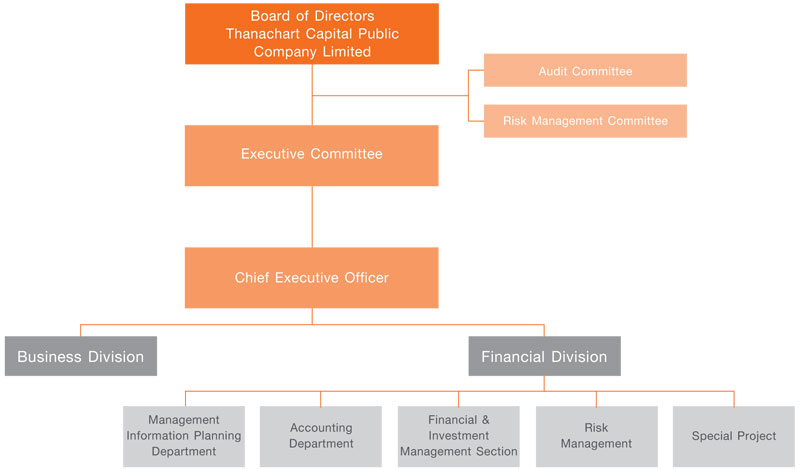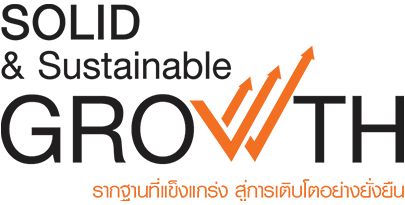Thanachart Capital Public Company Limited (“the Company”) Board of Directors has put in place written policy guidelines on corporate governance since 2003. The Board also conducts an annual review on corporate governance policies and the reporting process on business compliance with corporate governance principles of the Company, at least once per annum. The business ethics as well as codes of conduct for directors, executives, and staff have been improved in order to establish a framework for all personnel in the Company.
The Company has disclosed Corporate Governance Policy and Guide to Business Conduct on the Company’s website and Thanachart Group’s intranet system in order to communicate with staff of the Group at every level. In addition, Thanachart Group supports good corporate governance practices. It also instills in its staff the importance of both corporate governance and corporate social responsibility through its corporate policies and by offering a range of regular training and social activities for staff in the Group. To begin with, various training courses have been designed to include work practices which are based in morals, ethics, and the codes of professional conduct. In particular, the orientation course places emphasis on ensuring that new staff joining Thanachart Group recognize the s the importance of adhering to good corporate governance principles. In addition, to promote better access to training resources, E-learning applications have been made available to staff to provide them with more knowledge and better understanding to their work. Moreover, tests are organized annually to check employee understanding of the key components of their training. As well, the Company established a project entitled “Thanachart Can Do…Good Dharma & CG…Initiates and Fulfill Dharma”, by using videos as a tool to send messages to employees via Thanachart Group’s internal TV systems, namely “Thanachart Channel (T-Channel)”. The videos have been broadcasting at different times during the day, with the contents of the videos including the various activities whereby the employees practiced dharma, by thinking good thoughts and doing good deeds, as well as inculcating in themselves a sense of responsibility to one’s own duties. The major objective is to ensure that all employees in the organization understand good corporate governance and know how to put those principles into practice when appropriate.
NFS ASSET MANAGEMENT COMPANY LIMITED
Corporate Governance Policy and
Code of Business Conduct
Download
MAX ASSET MANAGEMENT COMPANY LIMITED
Corporate Governance Policy and
Code of Business Conduct
Download
TS ASSET MANAGEMENT COMPANY LIMITED
Corporate Governance Policy and
Code of Business Conduct
Download
Thanachart Capital Plc. (the “Company”) realizes the harmful and obtrusive effects of corruption on social and economic development. In essence, it is a wrong business practice, which creates uneven playing field and could damage ethical reputation and competitiveness of the Company leading to rejection from domestic and international entities as well as a decline in confidence among shareholders, investors, and all stakeholders. The Company, thus, adheres to the principles of not providing any support to any enterprise, group of people, or person involved in exploitation, either directly or indirectly, abusing their power/ authorities. The Company has a clear direction to cooperate with and support government as well as private sectors. It, thus, formulates the Anti-Corruption Policy in accordance with regulators’ guidelines and “the Private Sector Collective Action Coalition against Corruption (CAC)” as the key principles for directors, executives, and any employee to follow. Details are as seen below.
In 2016, the Thai economy continued to grow, thanks to the expansion of government investment and the continuous government stimulus measures as well as stronger growth of the tourism. At the same time, private consumption and private investment slightly grew with a limitation from not only external factors including the slowdown in major trading partners economies but also from internal factors including the sluggish export following the slowdown in trading partners economies, the high level of household and SMEs debts, and the drought.
The commercial bank loans continued to grow in 2016 when compared to the previous year. Although commercial banks have faced with various economic challenge factors, the stability of financial status remained strong as reflected in high capital adequacy and reserve level. However, commercial banks remained cautious in the conduct of their business affairs and applied stricter lending standards in approving loans.
As for 2017, the Thai economy is expected to continue improving with disbursements of public investment expenditure playing a major role of driving the economic growth. However, the growth remains fragile and there are several risk factors that need to be monitored closely. These factors may have negative impacts on risks in various areas including market risk, credit risk, and liquidity risk.
The Company is aware of risk factors and puts great emphasis on the risk management. TBANK, a subsidiary company, conducts the assessment of its capital by going through the Internal Capital Adequacy Assessment Process (ICAAP) which provides a framework for dealing with various risks. The assessment is in accordance with the measure imposed by the BOT for overseeing the capital base of commercial banks under Basel III. The assessment enables TBANK to manage its capital efficiently and place it in a strong capital position which can support sustainable future business expansion.
The Board of Directors and high-ranking executives of the Company still keep on overseeing, monitoring, and developing risk management systems on an on-going basis, ensuring that the various measures remain appropriate and timely in dealing with changing risks, both internal and external. The Company has also established an organization structure which support the risk management in line with the policy framework of various committees, with details as follows:
THE COMPANY’S RISK MANAGEMENT STRUCTURE
- The Company’s Board of Directors has a role in policy determination and establishes guidelines for an efficient enterprise-wide risk management including risk management and business continuity management of Thanachart Group-ensuring that it is efficient and in line with the Company’s operations by taking into consideration the impact of risks on the Company’s operational goal and financial position.
- Executive Committee has a role in considering and approving all activities to be in line with the Company’s risk management policies, as well as, assessing the business continuity management of Thanachart Group to present to the Company’s Board of Directors for approval.
- Risk Management Committee plays a role in proposing the Company’s risk management policy and the Group’s risk management policy to the Company’s Board of Directors for approval. The Committee also establishes risk management strategic plans to be in line with the risk management policy and revises the sufficient of the Company’s risk management policy including the efficiency of the system and practice of the specified policy. Furthermore, it has a role to control, monitor, and supervise the Company and the companies under the Group to comply with the risk management policy as well as regularly report the result of the compliance to the Board of Directors including the adjustments to conform to specified policies and strategies.
- Audit Committee has a role in determining the supervisory guidelines for the operation, ensuring that the Company and the Group are operating in compliance with measures of related authorities. The Committee also has a role in assessing the effectiveness and competency of the overall Group’s risk management process and sufficiency of overall internal control system.
THE COMPANY’S RISK MANAGEMENT STRUCTURE CHART
As of 31 December 2016

- The conduct of business affairs is under a system of check and balance with Middle Office, comprising of the Risk Control Unit and Back Office, being separated from the Front Office.
- The Company puts in writing all the established policies and guidelines regarding the risk management that specifies responsibilities of related unit as the operational guidelines for the employees. Moreover, the Company has established a four-step guideline for risk management. The guideline includes 1) the identification of the characteristics of risk as well as risk factors, 2) the development of appropriate tools and models for risk measurement, 3) the control of risks within acceptable limits, and 4) the close monitoring of risk status in order to properly manage any possible risks in a timely manner.
- The differences in size and risk ratios determined for each exposure measured by tools and models allowed the Company to be able to perceive the degree of severity from the possible risks. These risk variables could also be used as a ceiling or the acceptable risk level as well as to provide warning signals before severe losses occur.
- The risk management report is presented to the board of directors of each subsidiary company and the overview report is presented to the Company’s Board of Directors in a periodic and timely manner.
The aforementioned risk management systems are developed based on prudent principles and will be reviewed regularly to suit prevailing situations. The systems are designed to be transparent, explicit, and examinable, and to take into consideration the interests of shareholders, customers, and staff.
